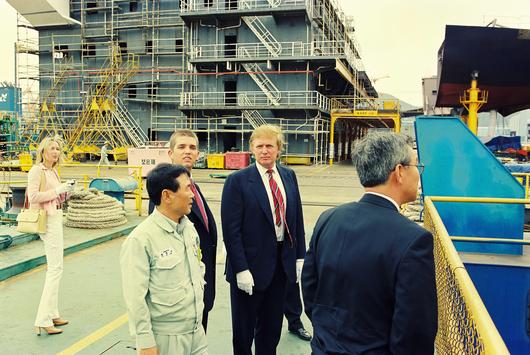 |
Donald Trump (second from the right), then a real estate developer, visited Daewoo Shipbuilding & Marine Engineering’s Okpo shipyard (now Hanwha Ocean) in Geoje, South Korea, in June 1998. Trump made his first visit to South Korea to discuss investment in "Daewoo Trump World," a proposed luxury residential and commercial complex. He toured various sites, including the shipyard and Daewoo Motors in Gunsan, Jeollanam-do. His eldest son, Donald Trump Jr. (third from the right), and his second wife, actress Marla Maples (far left), joined him. Trump, according to reports, requested to climb the 100-meter Goliath crane, where he repeatedly exclaimed, “Wonderful, amazing,” as noted by those present. /Chosun DB |
<이미지를 클릭하시면 크게 보실 수 있습니다> |
In a recent conversation with South Korean President Yoon Suk-yeol, U.S. President-elect Donald Trump highlighted South Korea’s renowned shipbuilding expertise, acknowledging the nation’s status as a global leader in the industry. Trump stated, “I am well aware of South Korea’s world-class shipbuilding and naval construction capabilities. Strengthening our cooperation with South Korea is crucial, not only in ship exports but also in the maintenance, repair, and overhaul (MRO) sector.” It is highly unusual for a U.S. president-elect to single out South Korean shipbuilding and seek industry collaboration during a congratulatory call.
Experts point to a growing strategic urgency as the U.S. grapples with the decline of its shipbuilding industry and intensifying competition with China for maritime dominance. While the U.S. retains advanced technology, including nuclear-powered submarines, its shipbuilding and repair infrastructure has significantly weakened. By 2023, the U.S. accounted for only 0.13% of global ship production, with repair wait times for submarines extending over several years. An American think tank reported that China’s shipbuilding capacity is 230 times greater than that of the U.S. In response, Congress’s April report, “Securing America’s Maritime Security: A National Maritime Initiative to Regain American Maritime Competitiveness,” recommended strengthening partnerships with allied nations. South Korean shipbuilding companies have already expanded their presence by acquiring U.S. shipyards and securing MRO contracts.
During World War II, the U.S. operated over 50 shipyards and produced more than 1,000 ships annually, contributing significantly to its wartime success. The Jones Act, which mandates that only U.S.-built ships operate between domestic ports, initially supported the domestic shipbuilding industry. However, as U.S. shipyards focused solely on the domestic market, they lost their global competitive edge, ceding market leadership first to Japan, then to South Korea, and most recently to China.
The decline of the U.S. shipbuilding industry has directly impacted naval strength. For example, the USS Connecticut, a Seawolf-class nuclear-powered attack submarine that collided with an underwater mountain in October 2021, waited 20 months before repairs began, with the repair period projected to last at least 31 months. Data shows that around 40% of the U.S. fast-attack submarine fleet is either under maintenance or awaiting repairs. Although the U.S. still leads China in the number of aircraft carriers, with 11 compared to China’s three, it lags in overall combat ship numbers, trailing 280 to China’s 370.
[Lee Jeong-gu]
- Copyrights ⓒ 조선일보 & chosun.com, 무단 전재 및 재배포 금지 -
이 기사의 카테고리는 언론사의 분류를 따릅니다.
언론사는 한 기사를 두 개 이상의 카테고리로 분류할 수 있습니다.


